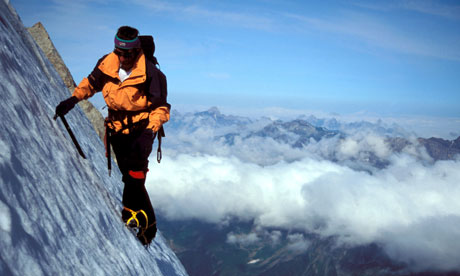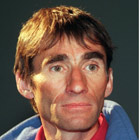'Night-naked' climber and only the third man to scale all 14 peaks above 8,000m

Erhard Loretan in 1998, below, and above, on the north face of L’Aiguille Verte in Chamonix, France.
It was no coincidence that Erhard Loretan, who has died in a fall aged 52, should have been working in the mountains on his birthday. For Loretan, any time spent among them was a gift. Whenever he spoke in public, as he did at the Royal Geographical Society in London in November 2010 to raise money for Community Action Nepal, he would thank the mountains for the life they had given him, both as a professional guide and as one of the greatest mountaineers of them all. 

Loretan's climbing record was phenomenal, whether on the highest Himalayan peaks or in his own back yard in the Swiss Alps. History records him as the third person to climb all 14 peaks over 8,000m, behind the Italian Reinhold Messner and the Pole Jerzy Kukuczka, but that barely scratches the depth and scope of what he achieved. Loretan took the principles of climbing fast and light in the Alps and applied them to the biggest mountains on Earth. The classic example of this was his ascent of Everest in 1986 with his climbing partner of 10 years, Jean Troillet. Climbing late in the monsoon, and confined for weeks to their base camp by bad weather, when conditions finally turned good the two Swiss were out of the traps like greyhounds. Leaving base camp in the late afternoon of 28 August, they skied to the foot of the north face and started up the Japanese couloir, climbing through the night unroped and at terrific speed. By early afternoon they had reached the base of the Hornbein couloir at 7,900m. Here they rested, dozing in the warmth of the day before continuing as night fell and the cold returned. After another night of lung-bursting effort – Loretan never used bottled oxygen – they emerged at the summit at 2pm on 30 August before racing back to base in five hours, much of it glissading. Loretan and Troillet's effort, up one of the peak's harder routes, stunned the mountaineering world, but Loretan was almost apologetic. "We didn't intend to climb Everest in two days," he said. "We didn't think we were doing incredible things. It all seemed normal." Loretan was born in Bulle, in the Swiss canton of Fribourg, and was always a restless, adventurous child. When he was seven, however, his father walked out, leaving his mother, Renata, to look after Erhard and his brother, Daniel. "Without him going," Loretan wrote, "perhaps I wouldn't have been a mountaineer." The boy came to admire his neighbour who headed off to the mountains with a rucksack on his back. It was just the sort of life Loretan was looking for. His cousin Fritz was the guardian of the Fründen Hut in the Bernese Alps, and the young Erhard would stay with him in the summer holidays. He climbed his first proper mountain, the Dent de Broc, aged 11 and his first north face aged 13. Yet Loretan was not just an athletic prodigy. He was entirely at home in the mountains. They were his natural habitat, reinforcing a sense of humility and modesty that bordered on the pathological. His friend and patron Rudolf Zingg called him "an anti-star", so reluctant was he to absorb any of the praise his successes earned him. He saw for himself the pressures and dangers in climbing and wanted none of it. At school in Gruyère, he fell in with an older group of dedicated alpinists, Pierre Morand, Jean-Maurice Chappalley and Vincent Charrière, and together they raced through the card of Alpine classics, the north faces of the Eiger, the Grandes Jorasses and much more besides. Loretan qualified top of his class as a cabinet-maker, but his future was not going to be spent in a workshop. Considering they were ready for anything, and admiring the Austrian Hermann Buhl, who had made the daring first ascent of Nanga Parbat in Pakistan, Loretan wrote to the French alpinist Yannick Seigneur, who had just been there. Seigneur rather grumpily replied that a poignèe de béotiens, a bunch of kids just out of school, should get some experience of altitude first. So Loretan went to the Andes and climbed three peaks over 6,000m, including Palcaraju, and then climbed Nanga Parbat, his first 8,000er, in 1982. Over the next decade and a half he worked his way through the other 13, in 1983 climbing three peaks in the Karakoram – Gasherbrum I and II, and Broad Peak – in just 17 days. His tactic was to go as light as possible, without tents or bottled oxygen or even a sleeping bag. Usually climbing unroped for speed, and fuelled by gruyère cheese, Loretan banked on the notion that the less time you spend high up, the less chance something will go wrong. Everest was an example of this, but there were even more committing climbs, such as his ascent in 1984 of Annapurna via its long east ridge with his compatriot Norbert "Noppa" Joos. This immense crest of the Annapurna massif stretches 7km at an altitude of never less than 7,500m, and after three days of wild isolation, they reached the summit, descending the dangerous north flank of the peak. There were setbacks too. In 1986, after Everest, he persuaded his friend Pierre-Alain Steiner, with whom he had climbed Dhaulagiri in winter for the first time, to try a new route on Cho Oyu. But this time their "night-naked" style, as it was dubbed, backfired. After being caught in bad weather, Steiner slipped as they retreated and fell hundreds of metres. It took Loretan an hour to climb down to Steiner, assuming he was dead, but Steiner had survived, albeit with terrible injuries. Loretan built an igloo and put his partner inside before racing back to base camp for help. There he discovered his Sherpa crew had gone, and it was another three days before he could get back to Steiner with help. Steiner was still alive but died during the rescue, pitching Loretan into a period of depression, a sense of guilt exacerbated by injuries he suffered in an avalanche, and then again while paragliding. As ever, the mountains healed him. In 1989, with André Georges, he climbed 13 north faces in the Bernese Oberland, including the Eiger, in just 13 days. In 1990, in memory of Steiner, he finished the new route on Cho Oyu with Troillet in just 27 hours. Loretan's final 8,000er was Kangchenjunga in 1995. While he was climbing dangerous routes, Loretan had resisted starting a family – he did not want to orphan a child – but after a few more adventures, he and his partner had a son, Ewan, in 2001. Panicked by Ewan's crying one evening at his chalet in Crésuz, Loretan shook the seven-month-old child three or four times, and put him back in his cot, where he seemed to settle. But Loretan had fatally injured the child, who died the next day, Christmas Eve. He was convicted of negligent manslaughter in 2003 and received a suspended sentence of four months. Stricken with guilt and horror at what he had done, he waived his right to anonymity to raise public awareness of the weakness of babies' necks. • Erhard Loretan, mountaineer, born 28 April 1959; died 28 April 2011
No comments:
Post a Comment